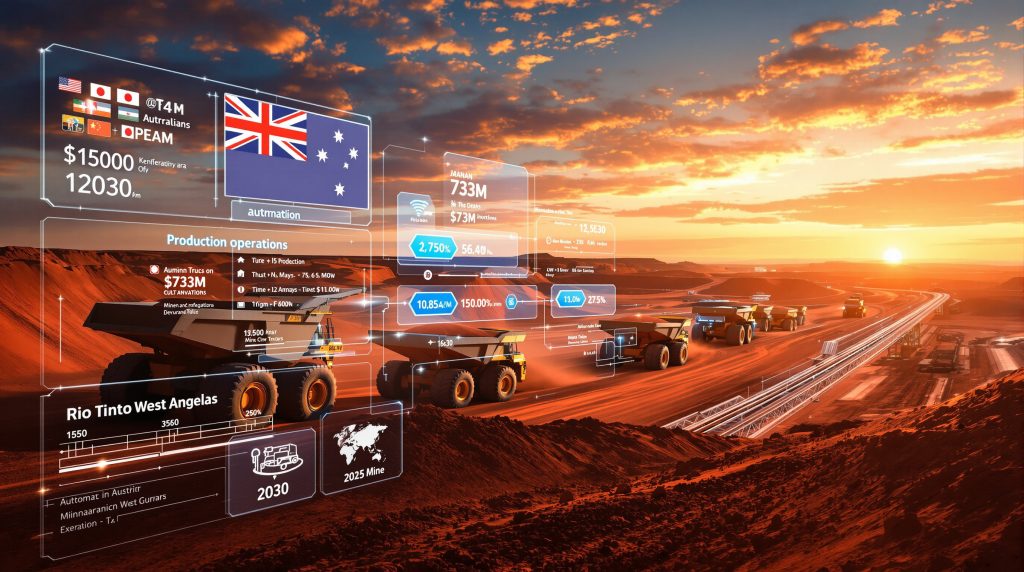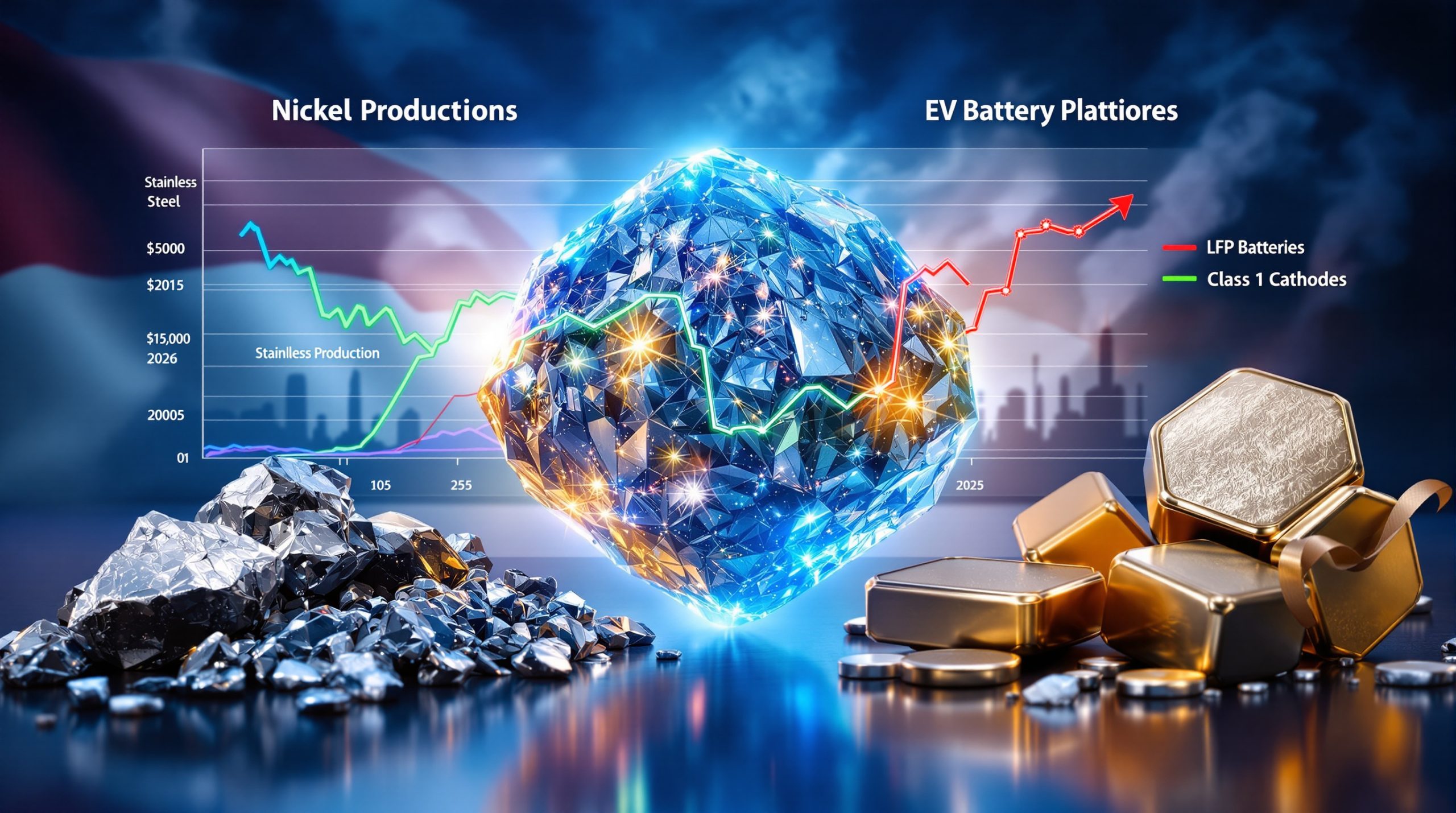What is the West Angelas Sustaining Project?
Rio Tinto, in collaboration with joint venture partners Mitsui Iron Ore and Nippon Steel, has committed to a significant $733 million investment in the West Angelas iron ore hub located in Western Australia's resource-rich Pilbara region. This strategic funding injection represents a critical move to extend the operational lifespan of this established mining site, with Rio Tinto directly contributing $389 million to the total investment package.
The West Angelas Sustaining project focuses specifically on developing new iron ore deposits within the existing hub's footprint. Unlike expansion initiatives that aim to increase output, this project's primary objective is to maintain the hub's current annual production capacity at 35 million tonnes while extending mining operations by several years.
From an economic perspective, this substantial investment will generate approximately 600 construction jobs during the development phase. Once operational, the project will support around 950 full-time positions, providing significant employment opportunities in the region.
Strategic Investment Overview
The project forms a crucial component of Rio Tinto's systematic approach to resource management in the Pilbara region. By focusing on sustaining rather than expanding production, the company aims to ensure the long-term viability of its operations while maintaining consistent output levels that meet market demand.
The investment decision underscores Rio Tinto's commitment to maintaining its strong presence in Western Australia's iron ore sector, which remains a cornerstone of the company's global operations and revenue generation. This project represents a carefully calculated move to secure future production without disrupting market dynamics through capacity expansion.
The joint venture structure, which includes Japanese steel producers Mitsui Iron Ore and Nippon Steel, also highlights the international significance of the project and reinforces the long-standing partnerships that have characterized Rio Tinto Pilbara iron ore project operations.
Technological Advancements
A notable aspect of the West Angelas Sustaining project is its planned technological transformation. The site is scheduled to implement autonomous trucking operations beginning in 2027, marking another step in Rio Tinto's broader digital mining strategy across the Pilbara region.
This shift toward autonomous operations aligns with industry trends toward increased automation and digitalization. The implementation of self-driving haulage systems will likely enhance operational efficiency, improve safety metrics, and potentially reduce environmental impacts through more precise vehicle movements and optimized fuel consumption.
The autonomous trucking initiative at West Angelas will integrate with Rio Tinto's existing digital infrastructure, which already includes remote operations centers and automated rail systems. This interconnected approach enables the company to manage complex mining operations with greater precision while reducing human exposure to potentially hazardous environments.
Beyond trucking automation, the project will incorporate advanced extraction and processing technologies that reflect Rio Tinto's commitment to operational excellence and resource efficiency. These technological enhancements support the company's dual objectives of maintaining production levels while potentially reducing operational costs over the long term.
How Does This Project Fit Into Rio Tinto's Broader Pilbara Strategy?
The West Angelas Sustaining project represents just one component of Rio Tinto's comprehensive approach to maintaining its iron ore production capacity across the Pilbara region. This strategic investment forms part of a suite of replacement iron ore developments that collectively support approximately 130 million tonnes of annual production capacity.
Rio Tinto's Pilbara operations represent one of the world's largest iron ore mines, encompassing multiple mining hubs connected by an extensive rail infrastructure that transports ore to port facilities for global export. The company's systematic approach to resource development ensures consistent production levels while managing the natural depletion of existing deposits.
Rather than pursuing aggressive expansion, Rio Tinto has adopted a measured replacement strategy that maintains overall output while extending the lifespan of established operations. This approach helps minimize market disruption while ensuring the company can continue meeting customer commitments over the long term.
Pilbara Production Framework
The West Angelas hub forms a critical link in Rio Tinto's integrated Pilbara production chain. Operating since 2002, this established mining operation has consistently contributed high-quality iron ore to the company's overall production portfolio for more than two decades.
Rio Tinto's broader Pilbara operations aim to maintain an annual production guidance of 323-328 million tonnes, making these Australian assets central to the company's position as a leading global iron ore supplier. The structured approach to resource replacement and development reflects a long-term planning horizon that extends well beyond individual project timelines.
This strategic framework allows Rio Tinto to sustain production levels despite the natural depletion of existing ore bodies, ensuring continuity of supply to key markets in Asia and beyond. The company's careful sequencing of investments across multiple sites enables it to maintain consistent output while managing capital expenditure efficiently.
West Angelas Historical Context
Since commencing operations in 2002, the West Angelas hub has established itself as a vital component within Rio Tinto's Pilbara network. Its strategic location provides access to high-quality iron ore deposits while benefiting from integration with the company's rail and port infrastructure.
The hub's longevity demonstrates both the quality of its resource base and Rio Tinto's commitment to maximizing the value of its established operations. Through multiple phases of development over more than two decades, West Angelas has consistently delivered value to Rio Tinto and its joint venture partners.
The established partnerships with Japanese steel producers Mitsui Iron Ore and Nippon Steel highlight the international significance of the operation and the long-term relationships that underpin Rio Tinto's Pilbara strategy. These collaborations provide not only capital sharing but also market security through alignment with major customers.
West Angelas' proven operational track record in challenging mining conditions has contributed valuable technical insights that inform Rio Tinto's approach across its broader Pilbara operations. This institutional knowledge supports continuous improvement initiatives while mitigating operational risks.
What Other Major Projects is Rio Tinto Developing in the Pilbara?
While the West Angelas Sustaining project focuses on extending the life of an existing operation, Rio Tinto is simultaneously advancing several other significant developments across the Pilbara region. These projects range from recently opened mines to early-stage studies for future operations, creating a pipeline of developments that will support production over the coming decades.
This balanced approach combines near-term production maintenance with medium and long-term growth opportunities, ensuring Rio Tinto can sustain its market position while adapting to changing industry dynamics. The company's project portfolio reflects a strategic mix of partnerships and wholly-owned developments that distribute risk while maximizing potential returns.
Rhodes Ridge Development
Among Rio Tinto's most significant future opportunities is the Rhodes Ridge project, which is currently undergoing pre-feasibility studies. This substantial development targets an initial production capacity of up to 40 million tonnes per annum, with first ore anticipated by 2030.
The scale of the Rhodes Ridge project positions it as a potential cornerstone of Rio Tinto's future Pilbara operations. With its substantial resource base and planned production capacity, this development represents a significant long-term investment in Western Australian iron ore resources.
The extended timeline for Rhodes Ridge reflects the complexity and scale of modern mine planning, which require extensive planning, environmental assessments, and infrastructure development before production can commence. This methodical approach helps ensure the project's technical and economic viability while addressing potential environmental and community impacts.
As the pre-feasibility study progresses, Rio Tinto will continue refining the project parameters to optimize capital efficiency and operational performance. The company's experience with similar large-scale developments across the Pilbara provides valuable insights that inform planning and execution strategies.
Western Range Mine
In contrast to the future-focused Rhodes Ridge project, Rio Tinto recently opened the $2 billion Western Range iron ore mine in partnership with China Baowu Steel Group. This newly operational development aims to sustain output from the Paraburdoo hub for up to two decades.
The Western Range project demonstrates Rio Tinto's commitment to maintaining production levels through targeted investments in new mining areas. By developing this site in partnership with China Baowu, one of the world's largest steel producers, Rio Tinto has secured both capital support and market alignment.
This strategic partnership approach highlights Rio Tinto's flexibility in structuring development models to suit specific project requirements. While some developments proceed as wholly-owned assets, others benefit from collaborative approaches that share investment burdens and market risks.
The Western Range mine's integration with the existing Paraburdoo hub infrastructure optimizes capital efficiency by leveraging established processing facilities and transport links. This approach enables more rapid development timeframes while reducing overall investment requirements compared to standalone operations.
What Economic Impact Will These Projects Have?
The economic footprint of Rio Tinto's Pilbara investments extends far beyond the direct capital expenditure figures. These projects generate significant employment opportunities, support regional development, and contribute to government revenues through taxes and royalties.
The cumulative impact of multiple simultaneous developments creates substantial economic activity across Western Australia, supporting both mining-specific sectors and broader service industries. This distributed economic effect helps sustain regional communities while contributing to national prosperity.
Regional Employment Benefits
The West Angelas Sustaining project alone will create approximately 600 construction jobs during the development phase, providing significant employment opportunities in a region where mining remains a primary economic driver. Once operational, the project will sustain around 950 full-time positions.
Beyond these direct employment figures, significant indirect job creation occurs throughout the supply chain and service provider network. From equipment maintenance and transportation to catering and accommodation services, the ripple effects of major mining investments support diverse employment opportunities across multiple sectors.
These projects also drive skills development and training initiatives that enhance workforce capabilities beyond individual project requirements. Rio Tinto's investments in training programs and apprenticeships help build regional capacity while providing career pathways for local residents.
The long-term nature of these mining operations provides economic stability for Pilbara communities, enabling infrastructure development and service provision that might otherwise be challenging in remote regions. This sustained economic activity supports community development and enhances quality of life for residents.
Investment in Western Australia
The substantial capital expenditure associated with these projects flows through multiple levels of the Western Australian economy. The $733 million West Angelas investment and $2 billion Western Range development represent significant direct injections that support local businesses, service providers, and employment.
Beyond project-specific expenditure, Rio Tinto's ongoing operations require extensive support infrastructure that benefits the broader regional economy. From transport networks to power supply and telecommunications, these enabling systems create economic value beyond the mining sector itself.
Tax and royalty contributions flowing from these operations provide substantial revenue to state and federal governments, supporting public services and infrastructure development. These financial flows represent a significant economic dividend from resource development that benefits the broader Australian community.
The scale and longevity of Rio Tinto's Pilbara operations strengthen Australian iron ore leadership position in global iron ore markets, contributing positively to trade balances and economic stability. As one of Australia's most significant export commodities, iron ore plays a critical role in national economic performance.
How Are Market Conditions Affecting Rio Tinto's Iron Ore Strategy?
The iron ore market operates within a complex global ecosystem influenced by steel production trends, economic growth patterns, and competitive dynamics. Rio Tinto's strategic decisions reflect careful analysis of these market conditions and their potential future evolution.
The company's measured approach to capacity maintenance rather than aggressive expansion suggests a nuanced understanding of market balance and the importance of disciplined capital allocation. This strategic positioning aims to maximize returns from existing assets while preparing selectively for future opportunities.
Current Market Dynamics
Following the announcement of the West Angelas investment, Rio Tinto shares rose 0.9% to A$124.72, outperforming the broader benchmark index, which declined 0.1%. This positive market reception indicates investor confidence in the company's strategic direction and capital allocation approach.
The market response suggests recognition of the value created through targeted investments that maintain production capacity without risking oversupply. By focusing on replacement rather than expansion, Rio Tinto demonstrates disciplined management of capital while preserving future optionality.
Strong investor confidence in iron ore price forecast and sector fundamentals underpins positive reactions to development announcements. Despite periodic price volatility, the essential role of iron ore in global steel production provides a foundation for long-term demand that supports strategic investments.
Rio Tinto's balanced approach to portfolio development, combining near-term production maintenance with longer-term growth options, enables adaptation to changing market conditions. This flexibility represents a significant competitive advantage in a market characterized by cyclical dynamics and evolving demand patterns.
Global Steel Industry Relationships
Rio Tinto's continued partnership with Japanese steel producers Mitsui Iron Ore and Nippon Steel on the West Angelas project highlights the importance of long-term customer relationships in the iron ore sector. These established connections provide market stability while aligning production with end-user requirements.
The company's recent collaboration with China Baowu Steel Group on the Western Range project demonstrates a similar strategic approach to customer engagement across different regional markets. By partnering with one of China's largest steel producers, Rio Tinto strengthens its position in this crucial market while sharing development costs.
This balanced portfolio of customer relationships across different regions helps mitigate market risks while ensuring broad market access. The diversification across Japanese and Chinese partners reflects the global nature of iron ore markets and the importance of maintaining multiple market channels.
The joint venture structures employed across these projects enable Rio Tinto to share investment burdens and market risks while maintaining operational control. This approach optimizes capital efficiency while creating mutual interests that support long-term stability in customer relationships.
What is the Environmental and Sustainability Approach?
Modern mining operations must balance production objectives with environmental responsibilities and sustainability commitments. Rio Tinto's approach to project development increasingly incorporates advanced environmental management practices, energy efficiency measures, and rehabilitation planning.
The integration of new technologies, particularly automation systems, offers potential environmental benefits through improved operational efficiency and reduced resource intensity. These advances align with broader industry trends toward more sustainable mining practices that minimize ecological impacts while maximizing resource utilization.
Modern Mining Practices
The planned implementation of autonomous technologies at West Angelas, scheduled to begin in 2027, represents an opportunity to reduce environmental footprint through improved operational precision. Autonomous systems typically achieve greater consistency in vehicle movements, potentially reducing fuel consumption and associated emissions.
Energy efficiency measures incorporated into new developments help minimize the carbon intensity of mining operations while reducing operational costs. These technologies range from advanced power management systems to optimized equipment utilization that maximizes productivity per unit of energy consumed.
Water management represents a particular challenge in the Pilbara's arid conditions, requiring sophisticated approaches to conservation, reuse, and responsible discharge. Modern mining operations employ closed-loop water systems where possible, minimizing freshwater requirements while preventing environmental contamination.
Rehabilitation planning is increasingly integrated into project development from the earliest stages, ensuring progressive restoration occurs throughout the operational lifespan rather than solely at closure. This approach improves environmental outcomes while distributing rehabilitation costs over the project lifetime.
The application of leading environmental management systems provides structured approaches to identifying, managing, and mitigating potential impacts. These systems incorporate regular monitoring and reporting mechanisms that enhance accountability while supporting continuous improvement.
Future-Focused Operations
The gradual transition to more automated operations at West Angelas by 2027 forms part of a broader technological evolution across Rio Tinto's Pilbara operations. This shift toward digital mining offers potential sustainability benefits through improved resource utilization and reduced operational intensity.
Reduced carbon intensity through technological innovation supports Rio Tinto's broader climate commitments and adapts operations to an increasingly carbon-constrained operating environment. These adaptations may become increasingly important as regulatory frameworks and market expectations evolve.
Optimization of resource extraction and processing maximizes recovery rates while minimizing waste generation, improving the overall resource efficiency of mining operations. Advanced ore sorting and processing technologies enable more selective mining approaches that reduce unnecessary material movement.
Balancing production efficiency with environmental protection requires sophisticated planning tools and operational systems that integrate environmental considerations into daily decision-making. This integrated approach ensures environmental factors receive appropriate weighting in operational choices.
Alignment with evolving global sustainability standards positions operations for long-term success in a market increasingly focused on environmental and social governance performance. By anticipating regulatory changes and stakeholder expectations, Rio Tinto aims to maintain its social license to operate while avoiding potential future compliance costs.
Comparative Analysis: How Does West Angelas Compare to Other Pilbara Operations?
The diverse portfolio of Rio Tinto's Pilbara operations encompasses projects at various development stages, each with distinct characteristics and strategic roles. Comparing these operations provides valuable insights into the company's overall approach to resource development and production management.
While production capacity and investment scale provide useful metrics for comparison, equally important are factors such as operational lifespan, technological implementation, and strategic positioning within the broader production network. These multidimensional comparisons inform understanding of each project's specific contribution to Rio Tinto's Pilbara strategy.
Production Capacity Comparison
| Project | Annual Production Capacity | Investment | Operational Timeline |
|---|---|---|---|
| West Angelas | 35 million tonnes | $733 million | Operational since 2002, extension underway |
| Western Range | 25 million tonnes | $2 billion | Recently opened, 20-year lifespan |
| Rhodes Ridge (planned) | Up to 40 million tonnes | Under study | First ore by 2030 |
This comparison highlights the relative scale and investment intensity of different operations, with West Angelas representing a well-established production hub requiring targeted investment for life extension. In contrast, Western Range represents a newer development with higher capital intensity, while Rhodes Ridge offers significant future scale but remains in planning phases.
The production capacity figures demonstrate Rio Tinto's approach to maintaining overall output through a combination of differently sized operations. Rather than relying on a few massive hubs, this distributed approach provides operational flexibility while mitigating concentration risk.
The varied investment levels reflect different development stages and infrastructure requirements, with brownfield expansions typically requiring less capital per tonne of capacity than greenfield developments. This efficiency advantage supports the economic case for extending existing operations where feasible.
Strategic Positioning
Each project within Rio Tinto's Pilbara portfolio fulfills a specific strategic function within the overall production framework. West Angelas represents a critical production maintenance project that sustains existing capacity through targeted investment in new deposits within an established operational footprint.
Western Range exemplifies Rio Tinto's partnership approach, developing new resources in collaboration with a major Chinese steel producer. This structure distributes investment risk while strengthening customer relationships and ensuring market access for the resulting production.
Rhodes Ridge represents a significant future growth opportunity with substantial production potential. This development provides longer-term optionality within Rio Tinto's portfolio, enabling potential production increases if market conditions support expansion.
The combined approach balances maintenance of existing operations with development of new resources, ensuring overall production stability while providing growth options. This strategic sequencing of investments helps maintain Rio Tinto's market position while managing capital expenditure efficiently.
Rio Tinto's integrated rail and port infrastructure connects these diverse operations into a cohesive production system, enabling operational flexibility and efficiency. This shared infrastructure represents a significant competitive advantage, reducing capital requirements for new developments while optimizing logistics costs.
What Are the Long-Term Implications for Rio Tinto's Iron Ore Business?
Rio Tinto's strategic investments across the Pilbara region have significant implications for the company's long-term position within global iron ore markets. These carefully sequenced developments support sustained production while building optionality for future market scenarios.
The company's methodical approach to resource development reflects both the substantial scale of its Pilbara operations and the extended planning horizons necessary for responsible resource management. This long-term perspective informs capital allocation, infrastructure development, and partnership strategies.
Production Sustainability
Rio Tinto's structured approach to resource replacement and development aims to maintain Pilbara production capacity around 330 million tonnes annually. This stability provides operational predictability while avoiding market disruption through significant capacity fluctuations.
The long-term planning horizon extending beyond 2030 reflects the extended development timelines for major mining projects and the importance of securing future production well before existing deposits reach depletion. This proactive approach helps avoid production gaps that could compromise market positions or customer relationships.
The balanced portfolio of operational, under-development, and future projects creates a pipeline of opportunities that can be accelerated or deferred depending on market conditions and strategic priorities. This flexibility provides valuable optionality in an industry characterized by cyclical dynamics and evolving iron ore demand insights and patterns.
Strategic management of resource depletion and replacement ensures continued access to high-quality ore bodies that meet market requirements while maintaining cost competitiveness. The systematic sequencing of developments optimizes capital efficiency while sustaining overall production levels.
The cumulative knowledge developed through decades of Pilbara operations provides Rio Tinto with significant technical and operational advantages in resource development. This institutional expertise supports efficient project execution while minimizing developmental risks.
Market Position Reinforcement
Rio Tinto's continued commitment to Western Australian iron ore underscores the strategic importance of these resources within the company's global portfolio. Despite geographical diversification across multiple commodities and regions, Pilbara iron ore remains a cornerstone of Rio Tinto's business model.
Maintenance of global competitive position requires consistent investment in both productivity improvements and resource replacement. Rio Tinto's disciplined capital allocation approach balances these requirements while generating returns for shareholders and maintaining balance sheet strength.
Strategic partnerships with key customers in Japan and China strengthen market access while distributing development costs and risks. These collaborative approaches align production with market requirements while creating mutual interests that support long-term relationship stability.
Investment in technology to enhance productivity and reduce costs represents an increasingly important competitive differentiator in global iron ore markets. Rio Tinto's early adoption of autonomous systems and digital technologies positions the company favorably within an industry experiencing accelerating technological change.
Focus on high-quality ore to meet evolving market requirements recognizes the growing premium for higher-grade products that support steel mill productivity and environmental performance. This quality emphasis aligns with industry trends toward greater product differentiation and specialized market segments.
Frequently Asked Questions
When will the West Angelas project be completed?
The West Angelas Sustaining project is currently under development, with autonomous trucking operations scheduled to begin in 2027. The project will progressively extend the operational lifespan of the existing mining hub over several years.
How many jobs will the project create?
The West Angelas Sustaining project will create approximately 600 construction jobs during the development phase. Once operational, the project will sustain around 950 full-time positions, providing significant employment opportunities in the Pilbara region.
What is Rio Tinto's total iron ore production capacity in the Pilbara?
Rio Tinto maintains a production guidance for the Pilbara region of 323-328 million tonnes annually, making these Australian assets central to the company's position as a leading global iron ore supplier.
Who are Rio Tinto's partners in the West Angelas project?
Rio Tinto is partnering with Mitsui Iron Ore and Nippon Steel in the West Angelas joint venture, with Rio Tinto contributing $389 million of the total $733 million investment. These Japanese steel producers have been long-term partners in the West Angelas operation since its inception.
What future projects is Rio Tinto developing in the Pilbara?
Beyond West Angelas, Rio Tinto is advancing the Rhodes Ridge project, which targets an initial capacity of up to 40 million tonnes per annum with first ore expected by 2030. The company also recently opened the $2 billion Western Range iron ore mine in partnership with China Baowu Steel Group.
Ready to Spot the Next Major Mineral Discovery?
Discovery Alert's proprietary Discovery IQ model instantly identifies significant ASX mineral discoveries, turning complex data into actionable investment insights. Visit our discoveries page to understand how major mineral discoveries can lead to substantial returns and begin your 30-day free trial today.




